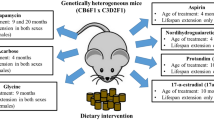Abstract
The previous 20 years of basic research on aging has identified a large number of genes and gene products whose expression can be manipulated in a variety of ways to increase the healthy life span of animal models such as yeast, nematodes, fruit flies, and mice. In an overt attempt to capitalize on this information, the National Institute on Aging (NIA) began a program in 2003 to identify nutritional and pharmaceutical interventions that could be safely employed to extend the healthy life span of mice. This program is called the Intervention Testing Program (ITP), and this article briefly describes the development of this initiative and some of the early success achieved during its first 10 years (2004–2014) of operation.
Similar content being viewed by others
References
Friedman DB, Johnson TE (1988) A mutation in the age-1 gene in Caenorabditis elegans lengthens life and reduces hermaphrodite fertility. Genetics 118:75–86
Harrison DE, Strong R, Sharp ZD, Nelson JF, Astle CM, Flurkey K et al (2009) Rapamycin fed late in life extends the life span of genetically heterogeneous mice. Nature 460:392–396
Harrison DE, Strong R, Allison DB, Ames BN, Astle CM, Artamma H et al (2014) Acarbose, a 17-alpha estradiol and nordihydroguarietic acid extend mouse lifespan preferentially in males. Aging Cell 13:273–282
Hasty P, Livi CB, Dodds SG. Jones D, Strong R, Javors M, et al (2013) eRapa restores a normal life span in a FAP mouse model. Cancer Prev Res 7(1)
Hayden EC (2014) Pet dogs set to test anti-aging drug. Nature 514:546
Kaeberlein M, Kennedy BK (2009) A midlife longevity drug. Nature 460(7253):331–332
Leslie M (2013) A putative antiaging drug takes a step from mice to men. Science 342:789
Mannick JB, Del Giudice G, Lattanzi M, Valiante NM, Praetgaard J, Huang B et al (2014) mTOR inhibition improves immune function in the elderly. Sci Transl Med 6:268ra 179
Miller RA, Harrison DE, Astle CM, Floyd RA, Flurkey K, Hensley KL et al (2007) An aging intervention testing program: study design and interim report. Aging Cell 6:565–575
Miller RA, Harrison DE, Astle CM, Bauer JA, Boyd AR, DeCabo R et al (2011) Rapamycin, but not resveratrol or simvastatin, extends life span of genetically heterogeneous mice. J Gerontol A Biol Sci Med Sci 66:191–201
Miller RA, Harrison DE, Astle CM, Fernandez E, Flurkey K, Han M et al (2014) Rapamycin-mediated lifespan increase in mice is dose and sex dependent and metabolically distinct from dietary restriction. Aging Cell 13:468–477
Powers RW III, Kaeberlein M, Caldwell SD, Kennedy BK, Fields S (2006) Extension of chronological life span in yeast by decreased TOR signaling. Genes Dev 20:174–184
Sharp ZD, Strong R (2010) The role of mTOR signaling in controlling mammalian life span: what a fungicide teaches us about longevity. J Gerontol A Biol Sci Med Sci 65:580–589
Sierra F (2010) Rapamycin joins the aging fray. J Gerontol A Biol Sci Med Sci 65:577–579
Strong R, Miller RA, Astle CM, Floyd RA, Flurkey K, Hensley et al (2008) Nordihydroguarietic acid and aspirin increase lifespan of genetically heterogeneous male mice. Aging Cell 7:641–650
Strong R, Miller RA, Astle CM, Bauer JA, de Cabo R, Fernandez E et al (2013) Evaluation of resveratrol, green tea extract, curcumin, oxaloacetic acid, and medium chain triglyceride oil on life span of genetically heterogeneous mice. J Gerontol A Biol Sci Med Sci 68:6–16
Warner HR, Ingram D, Miller RA, Nadon NL, Richardson AG (2000) Program for testing biological interventions to promote healthy aging. Mech Ageing Dev 115:199–208
Warner HR (2003) Subfield history: use of model organisms in the search for human aging genes. Sci Aging Knowledge Environ (6):re1
Wilkinson JE, Burneister L, Brooks SV, Chan C-C, Friedline S, Harrison DE et al (2012) Rapamycin slows aging in mice. Aging Cell 11:675–682
Acknowledgments
The author gratefully acknowledges suggestions made by Nancy Nadon of the National Institute on Aging and Donald Ingram of the Pennington Biomedical Research Center during the preparation of this manuscript.
Author information
Authors and Affiliations
Corresponding author
About this article
Cite this article
Warner, H.R. NIA’s intervention testing program at 10 years of age. AGE 37, 22 (2015). https://doi.org/10.1007/s11357-015-9761-5
Received:
Accepted:
Published:
DOI: https://doi.org/10.1007/s11357-015-9761-5




